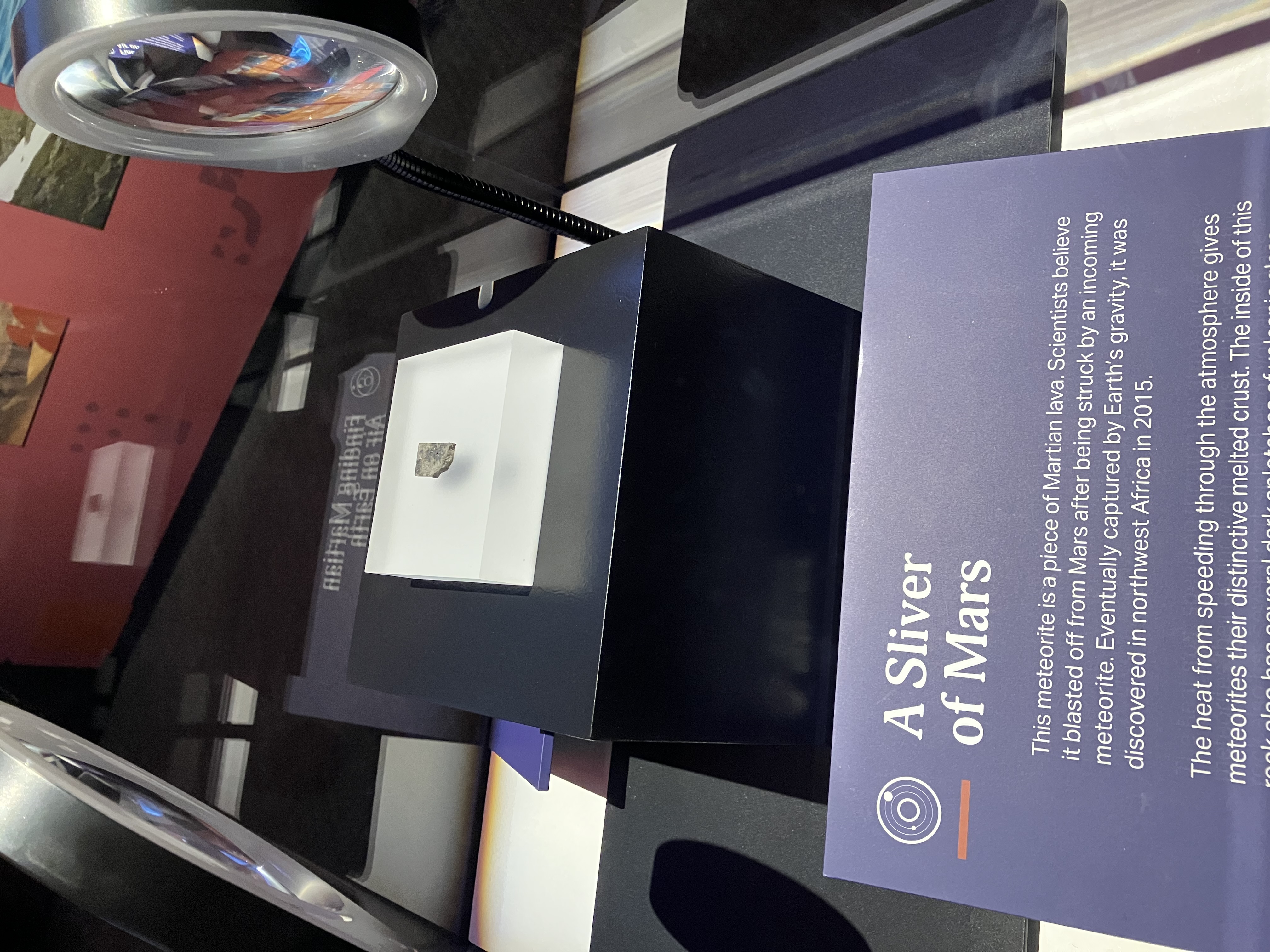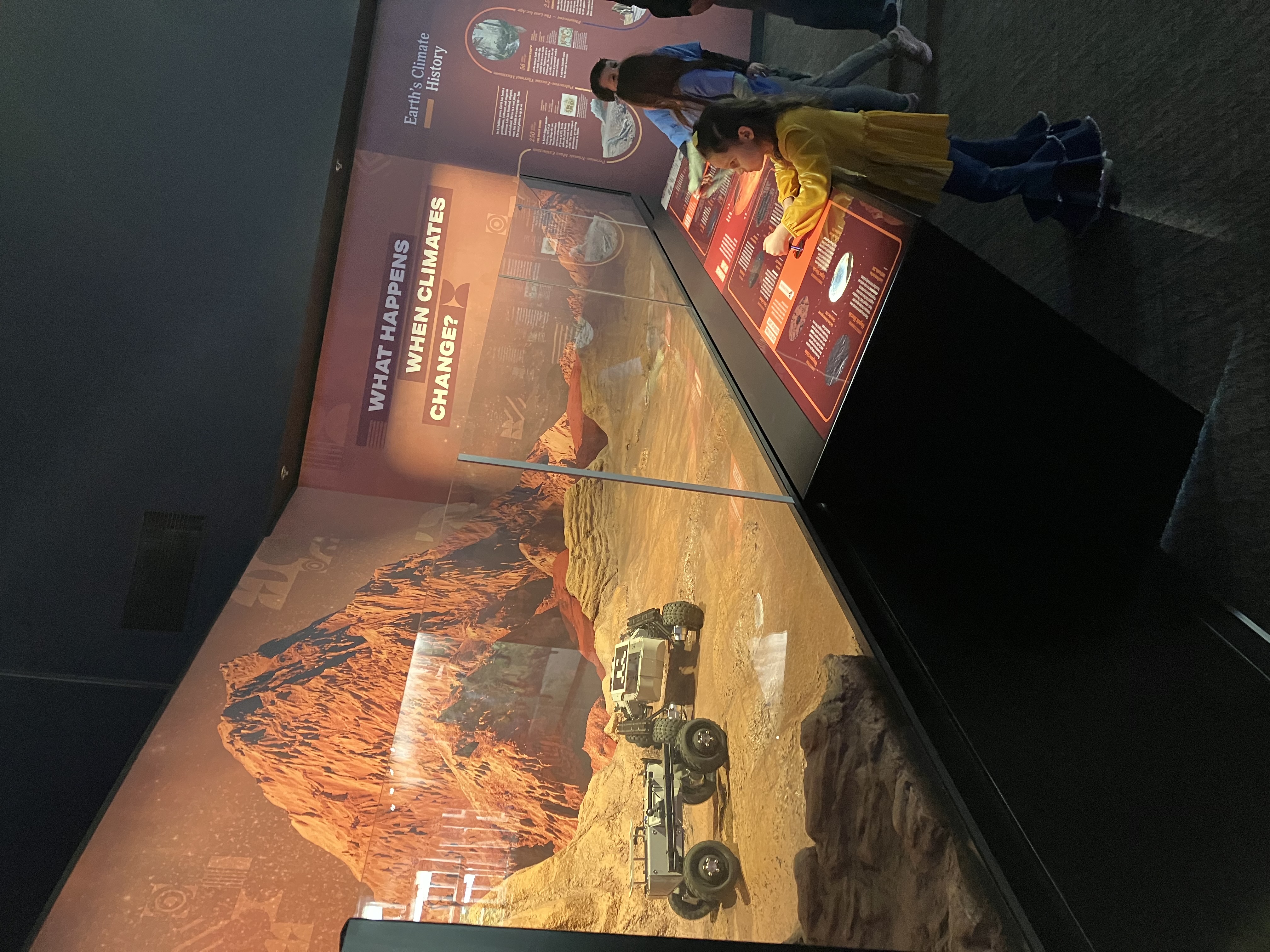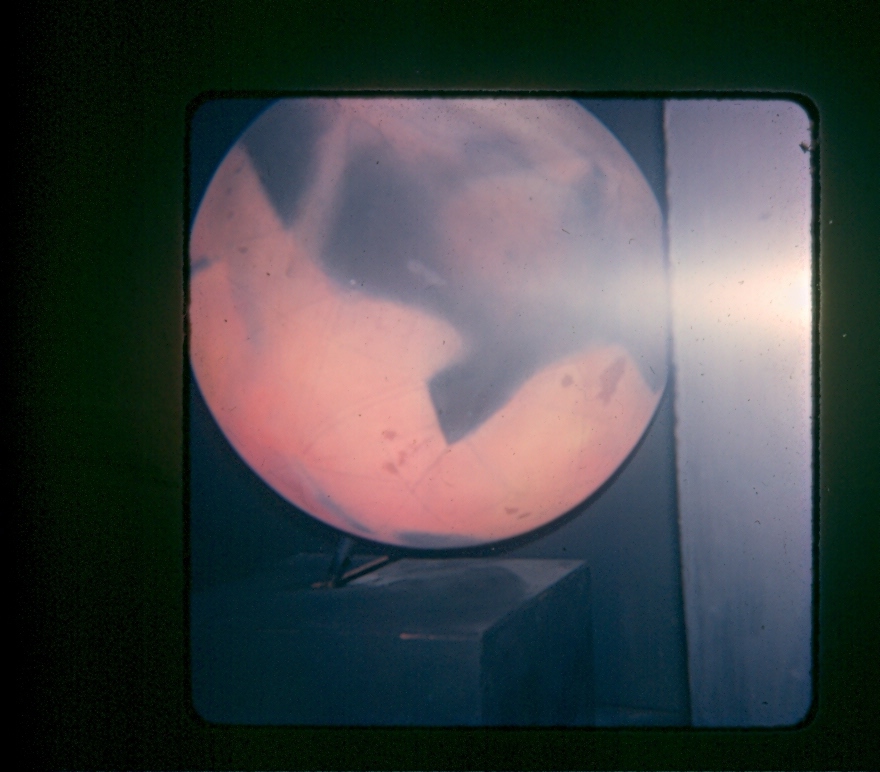
Meteorite from the planet Mars, on display as part of the new exhibit, Mars: The Next Giant Leap, at The Carnegie Science Center in Pittsburgh. A Moon rock, found during the 1971 mission of Apollo 15, is also on display; one of the astronauts to land on the Moon during this mission was James B. Irwin, a native of the Beechview section of Pittsburgh.
(Image Source: Friends of the Zeiss; Photographer: Glenn A. Walsh)
(More photographs of exhibit at this link: Link >>> https://andrewcarnegie.tripod.com/csc/pix/mars/ )
By Glenn A. Walsh
Reporting for SpaceWatchtower
Late last year, a new, 7,400 square-foot / 2,255.52 square-meter exhibit, titled, Mars: The Next Giant Leap, opened in The Carnegie Science Center in Pittsburgh. Divided in seven experiential zones, the exhibit focuses on future human exploration of, and possible settlement on, the Red Planet.
The new exhibit, which cost an estimated $4.48 million, includes a slice of a meteorite that scientists believe came from the planet Mars. The rock, from which the meteorite slice came from, probably fell to Earth after being knocked off of Mars by a larger meteorite or asteroid which hit Mars in the distant past.
Also displayed is a Moon rock (Lunar Sample #15499), on loan from NASA for at least five years, collected by Apollo 15 astronauts in 1971. One of the Apollo 15 astronauts to land on the Moon was James B. Irwin, a native of the Beechview section of Pittsburgh.
Other meteorites are on display, nearby, in the lobby of the Henry Buhl, Jr. Planetarium. One large meteorite, which the public can touch, is the fifth largest fragment of the large meteorite that created Meteor Crater in Arizona; this particular meteorite, Property of the City of Pittsburgh, was first displayed at Pittsburgh's original Buhl Planetarium and Institute of Popular Science in 1939. Another meteorite on display was collected by University of Pittsburgh Professor William Cassidy, during one of his expeditions to Antarctica.
Mars Closest Approach to Earth & Opposition
Mars: The Next Giant Leap opened to the public on Saturday, 2022 November 19, shortly before the bi-annual close approach of Mars to the Earth. Actually, Earth and Mars reach the closest point to each other every two years and two months.
The planet Mars was at its closest approach to Earth on Wednesday, 2022 November 30 at 9:00 p.m. Eastern Standard Time (EST) / December 1 at 2:00 Coordinated Universal Time (UTC). Mars was at its brightest in Earth's night sky at a Visual Magnitude of -1.8 with the Martian disk appearing as large as 17.2 seconds-of-arc in diameter. At that time, Mars was just 4.5 light-minutes away (distance of 0.544 Astronomical Unit / 50,567,959 statute miles / 81,381,241.409 kilometers).
Mars was in Opposition (with the Earth lying directly between Mars and the Sun - Mars visible all-night-long, approximately local sunset to local sunrise) on Thursday, 2022 December 8 at 1:00 a.m. EST / 6:00 UTC. The one week difference between Mars' closest approach to Earth and Mars' Opposition is due to the asymmetric nature of the Martian orbit.
The Red Planet appeared fairly close to the December Full Moon (“Cold Moon” on Wednesday, 2022 December 7 at 11:08 p.m. EST / December 8, 4:08 UTC). In fact, the Moon completely covered the planet Mars, in what astronomers call an Occultation, on Wednesday, 2022 December 7 at 11:00 p.m. EST / December 8 at 4:00 UTC. Amazingly, this occurred when Mars and Earth's Moon were both opposite the Sun and 100 per-cent illuminated by the Sun, but far enough north of the Ecliptic that there was no Lunar Eclipse / Eclipse of the Moon.
This Lunar Occultation was visible, weather-permitting, in most of the United States (except Alaska), Canada, Greenland, northwestern portion of Mexico, Svalbard (archipelago part of Norway), much of Europe, western portion of Russia, and a portion of northern Africa. For other observers, Mars was in Conjunction with the Full Moon (Mars 0.5 degree south of the Moon).
Today, Mars is still bright in the evening sky, but through much of the month Mars' brightness is beginning to wane. Although it will still be pretty bright at the end of January, the brightness will be 50 per-cent dimmer than at the beginning of the month as Earth and Mars separate. Look for Mars high in the east in evening twilight, and in the south later in the night, weather-permitting.
Again, there will be another Lunar Occultation of Mars late on Monday Evening, 2023 January 30 at 11:00 p.m. EST / January 31 at 4:00 UTC (Moon Phase: Waxing Gibbous). This Occultation will be visible, weather-permitting, in the southern portion of the United States, Mexico, Central America, Caribbean, northern section of South America, and most of Polynesia (but not New Zealand). Other areas will see Mars as little as 0.1 degree north of the Moon.

A simulated Martian landscape, where visitors can control miniature Mars rovers, while trying to search for evidence of past life.
(Image Source: Friends of the Zeiss; Photographer: Glenn A. Walsh)
(More photographs of exhibit at this link: Link >>> https://andrewcarnegie.tripod.com/csc/pix/mars/ )Exhibit Experiential Zones
The Carnegie Science Center used focus groups of students and North Side, Pittsburgh residents, as well as seeking input from local business leaders, to help design the new exhibit. In the focus groups, questions such as “Why go to Mars?” and “How do you form a new society on the planet?” were asked by the participants. Future input from Science Center visitors will help further develop parts of the exhibit.
The following are the seven experiential zones of the new exhibit ---
View from Mars – This zone provides images of the Martian landscape and perspectives of Earth. It talks about how robotic exploration of Mars, as well as science-fiction and pop-culture, has influenced our view of the Red Planet.
Climatology – This zone looks at how climates produce the conditions for life to arise. This area considers the climate systems of Mars and Earth, the abilities of each to sustain life, and what similar conditions may be found on the two planets. This zone includes a meteorite scientists believe originated on Mars.
Martian Garden - Greening of the Red Planet is the focus of this zone. Sustainability and resource management are vital for the survival of humans, and whatever other animals are brought to Mars. Three Pods show Soiless Growing (very little soil exists on Mars), Soil Growing, and Biotechnology on Mars.
Martian Living – This zone looks at life on Mars, from the viewpoint of possible Mars settlers. This area looks at technology needed to support human living on Mars. This area includes a Moon rock (Lunar Sample #15499), on loan from NASA for at least five years, which was collected by the two astronauts who landed on the Moon in 1971 during the mission of Apollo 15; one of these astronauts was James B. Irwin, a native of the Beechview section of Pittsburgh. This area also talks about possible challenges from Martian Living such as a weakened or lost human immune system (from a sterile environment), how bones may become denser and more brittle (due to lower gravity), and whether more prevalent DNA mutations (from DNA damage caused by greater Cosmic Rays) could turn setters into a new species—true Martians!
Dream Big: Space – This zone includes an imagined Martian settlement, which exhibit visitors can help design. Visitors' input will be immediately displayed on a digital model, and over-time may be added to the physical model. This area asks several questions about possible future Martian settlements, including, “In an isolated world, will we guarantee the right to return to Earth?”
Pittsburgh in Mars – This zone looks at humanity's future in Outer Space. In particular, it shows how Pittsburgh academic and corporate research is helping move humans into Outer Space and onto Mars. This area includes profiles of NASA Space Shuttle Astronaut Mike Fincke, University of Pittsburgh Engineering Professor Albert To, Carnegie Mellon University Robotics Professor Howie Choset, Carnegie Mellon University (CMU) Lead Systems Engineer Siri Maley (CMU's IRIS Rover to travel to the Moon; IRIS is Siri spelled backwards!), Carnegie Mellon University Civil and Environmental Engineering Professors Burcu Akinci and Mario Berges, Carnegie Mellon University Creative Technologist Angelica Bonilla Fominaya (spacesuit user interface), Howmet Aerospace Vice President Markus Heinimann, Arconic Corporation (aluminum-lithium low-weight, alloy plates for NASA spacecraft), and Kennametal Corporation (metal-cutting tools for NASA spacecraft).
Search for Life – Scientists believe that, at one time, the Martian climate was similar to Earth's current climate. So, Mars is one of the most logical places to look for evidence of past life in our Solar System. This also looks at possible life impacts on climate. In this area, visitors can control miniature Martian rovers on a simulated Martian landscape, in a search for signs of life.
More on The Carnegie Science Center.
The Carnegie Science Center is located on the Lower North Side of Pittsburgh, on the North Shore of the Ohio River about a mile from Downtown Pittsburgh's Golden Triangle. The Science Center building is located between Acrisure Stadium (home of the Pittsburgh Steelers and the University of Pittsburgh Panthers football teams) and Rivers Casino and Hotel. The Carnegie Science Center is about a block south of the Allegheny Light Rail Rapid Transit Station (served by the "T" Red, Blue, and Silver Line trains) of Pittsburgh Regional Transit (a.k.a. Port Authority of Allegheny County Transit). Three parking lots (including one at the rapid transit station) are available for visitors coming by automobile.
The Carnegie Science Center is open six days a week, 10:00 a.m. to 5:00 p.m. Eastern Time, Wednesday through Monday; the building is closed on Tuesday. Admission charges are --- Adults: $20; Senior Citizens (age 65 and greater): $15; Children (ages 3 to 12): $12; and Toddlers (age 2 and under): No Charge.
Adjacent to this Mars exhibit, on the second floor of The Carnegie Science Center, is the recently renovated Henry Buhl, Jr. Planetarium. On the day of the author's visit (Wednesday, 2022 November 23), four planetarium sky shows and one laser-light concert were performed for the public in the planetarium theater: “Story Time Under the Stars” (11:00 a.m. - geared to ages 6 and younger and their families), “Two Small Pieces of Glass” (12:00 Noon), “Stars Over Pittsburgh” (1:00 p.m.), “Laser Galactic Odyssey” (2:00 p.m.), “Beginner's Guide to the Universe” (3:00 p.m.), and “Big Astronomy” (400 p.m.). Each show lasts about a half-hour, and all planetarium shows are included in the General Admission Fee; laser-light shows (such as the 2:00 p.m. show) require an additional admission ticket.
Exhibits in the Henry Buhl, Jr. Planetarium Lobby include the fifth largest meteorite fragment (iron-nickel meteorite weighing 746 pounds / 340 kilograms) from Arizona's Barringer Meteor Crater. Visitors are encouraged to touch this meteorite. Also on display is a smaller meteorite found in Antarctica by University of Pittsburgh Professor William A. Cassidy.
In the Henry Buhl, Jr. Planetarium Lobby, visitors can also determine their weight on Mars, as well as their weight on Earth, the Moon, and Venus, on the historic Fairbanks-Morse Planetary Weight Scale. As the Arizona meteorite fragment and the Fairbanks-Morse scale were both originally displayed at the dedication of the original Buhl Planetarium and Institute of Popular Science on Tuesday Evening, 1939 October 24, both are the Property of the City of Pittsburgh.
On Saturday, 2022 October 15 just four blocks north of The Carnegie Science Center, a $2.7 million Moonshot Space Museum, regarding robotic missions to the Moon, opened. The museum is adjacent to, and operated by, Astrobotic Technology, Inc., which plans to send a robotic rover to the Moon this year. Near the end of this blog-post is the link to a blog-post describing the new Moonshot Space Museum.

The planet Mars, as displayed in a classic, display-case exhibit in the Hall of the Universe (1950s to 1994) at the original Buhl Planetarium and Institute of Popular Science / Buhl Science Center, America's fifth major planetarium and Pittsburgh's science and technology museum from 1939 to 1991.
.(Image Source: Friends of the Zeiss; Photographer: Francis G. Graham, Professor Emeritus of Physics, Kent State University)
Mars Often Featured at the Original Buhl Planetarium
The predecessor of The Carnegie Science Center was the original Buhl Planetarium and Institute of Popular Science (a.k.a. Buhl Science Center), America's fifth major planetarium and Pittsburgh's science and technology museum from 1939 to 1991. The original Buhl Planetarium building, now used by the Children's Museum of Pittsburgh, is located in Allegheny Center, one mile northeast of The Carnegie Science Center.
Mars was often the topic of science programming at the original Buhl Planetarium.
For decades (1950s to 1994), a classic, display-case exhibit showing the planet Mars was displayed in the Hall of the Universe of the original Buhl Planetarium. This exhibit showed the topography of Mars, as determined by telescopic images of Mars taken in the 1950s.
Two weight scales at the original Buhl Planetarium helped visitors determine what they would weigh on Mars: Fairbanks-Morse Planetary Weight Scale (in addition to Mars, visitors could determine their weight on Earth, Earth's Moon, and Venus on this scale); Toledo Planetary Weight Scale (three additional Toledo scales allowed visitors to determine their weight on Earth, the Moon, and Jupiter). The historic Fairbanks-Morse scale (Property of the City of Pittsburgh) continues to be available to the public in the Henry Buhl, Jr. Planetarium Lobby on the second floor of The Carnegie Science Center.
From time-to-time, the Buhl Planetarium sky show performance, in the original Theater of the Stars, would be about Mars. This includes a show titled, “The Red Planet Mars” in April of 1988, ahead of the Perihelic Opposition of Mars on 1988 September 28 (closest approach to Earth: 1988 September 22). The historic Zeiss II Planetarium Projector (Property of the City of Pittsburgh), which presented all planetarium sky shows from 1939 to 1991, is now on static display in the Space Place exhibit in The Carnegie Science Center's first-floor Atrium Gallery.
“Mars in 3-D”, a popular motion picture produced by NASA, was often shown to the general public in Buhl Planetarium's Little Science Theater (250-seat Lecture Hall); each visitor attending the film was given a pair of 3-D glasses to view the production. This 1979 film included 3-D images of Mars, taken by the Viking 1 and Viking 2 spacecraft, beginning in the Summer of 1976.
Mars was often the featured object shown to the public, particularly when Mars was close to Earth, in the original Buhl Planetarium Astronomical Observatory. Buhl's Astronomical Observatory was open for public observing every Friday evening 7:30 to 10:30 p.m. Eastern Time (ET), weather-permitting, year-round---also, some Thursday, Saturday, and Sunday evenings, weather-permitting, during the months of November through February (except the evenings of Christmas Eve and Christmas Day, when the building was closed) each year.
In addition to the opening of Mars: The Next Giant Leap exhibit on November 19, November 19 also marked the 81st anniversary (Wednesday Evening, 1941 November 19) of the Astronomical Observatory at the original Buhl Planetarium and Institute of Popular Science. The Astronomical Observatory's primary instrument was a rather unique, and now historic, 10-inch Siderostat-type Refractor Telescope (Property of the City of Pittsburgh).
The original Buhl Planetarium / Buhl Science Center also displayed a Moon Rock, collected by the Apollo astronauts, for the general public twice. The first time was in the Spring of 1970, shortly after the beginning of the manned lunar landings. The second time was in the Summer of 1989, in commemoration of the 20th anniversary of the Apollo 11 landing.
ADDENDUM - More Photographs of the new Mars: The Next Giant Leap Exhibit:
Link >>> https://andrewcarnegie.tripod.com/csc/pix/mars/
Internet Links to Additional Information ---
Mars: The Next Giant Leap Exhibit at The Carnegie Science Center:
Link >>> https://carnegiesciencecenter.org/exhibits/mars/
Photographs of some additional exhibits at The Carnegie Science Center:
Link >>> https://andrewcarnegie.tripod.com/csc/photoalbum.html
Mars: Link >>> https://en.wikipedia.org/wiki/Mars
The Carnegie Science Center: Link >>> https://carnegiesciencecenter.org/
Historic Buhl Planetarium & Institute of Popular Science / Buhl Science Center:
Link >>> http://www.planetarium.cc/
NASA Apollo 15 Astronaut James B. Irwin, Pittsburgh native who landed on Moon:
Link >>> https://buhlplanetarium2.tripod.com/bio/Pghastronauts.html#irwin
Related Blog-Posts ---
"Moonshot Space Museum Opens in Pittsburgh." Thur., 2022 Oct. 20.
Link >>> https://spacewatchtower.blogspot.com/2022/10/moonshot-space-museum-opens-in.html"Science Museums Rebound After Worst of Pandemic." Tue., 2022 Sept. 27.
Association of Science & Technology Centers (ASTC) 2022 Conference in Pittsburgh
Link >>> https://spacewatchtower.blogspot.com/2022/09/science-museums-rebound-after-worst-of.html
"50th Anniversary: Pittsburgh Native Walks on Moon." Mon., 2021 July 26.
"Pittsburgh Museum Displays Historic Apollo 11 Moon Mission Artifacts." Wed., 2018 Oct. 24.
"Mars Rover Sees Mystery Rock Suddenly Appear." Mon., 2014 Jan. 20.
Reporting for SpaceWatchtower
Source: Glenn A. Walsh Reporting for SpaceWatchtower, a project of Friends of the Zeiss
Wednesday, 2023 January 11.
Like This Post? Please Share!
More Astronomy & Science News - SpaceWatchtower Twitter Feed:
Link >>> https://twitter.com/spacewatchtower
Astronomy & Science Links: Link >>> http://buhlplanetarium.tripod.com/#sciencelinks
Want to receive SpaceWatchtower blog posts in your in-box ?
Send request to < spacewatchtower@planetarium.cc >.
gaw
Glenn
A. Walsh, Informal Science Educator & Communicator
(For more than 50 years! -
Since Monday Morning, 1972 June 12):
Link >>> http://buhlplanetarium2.tripod.com/weblog/spacewatchtower/gaw/
Electronic Mail: < gawalsh@planetarium.cc >
Project Director, Friends of the Zeiss: Link >>> http://buhlplanetarium.tripod.com/fotz/
SpaceWatchtower Editor / Author: Link >>> http://spacewatchtower.blogspot.com/
Formerly
Astronomical Observatory Coordinator & Planetarium Lecturer,
original Buhl Planetarium & Institute of Popular Science (a.k.a.
Buhl Science Center), America's fifth major planetarium and Pittsburgh's
science & technology museum from 1939 to 1991.
Formerly Trustee,
Andrew Carnegie Free Library and Music Hall, Pittsburgh suburb of
Carnegie, Pennsylvania, the fourth of only five libraries where both construction and endowment funded by famous industrialist & philanthropist Andrew Carnegie.
Author of History Web Sites on the Internet --
* Buhl Planetarium, Pittsburgh: Link >>> http://www.planetarium.cc Buhl Observatory: Link >>> http://spacewatchtower.blogspot.com/2016/11/75th-anniversary-americas-5th-public.html
* Adler Planetarium, Chicago: Link >>> http://adlerplanetarium.tripod.com
* Astronomer, Educator, Optician John A. Brashear: Link >>> http://johnbrashear.tripod.com
* Andrew Carnegie & Carnegie Libraries: Link >>> http://www.andrewcarnegie.cc
* Other Walsh-Authored Blog & Web-Sites: Link >>> https://buhlplanetarium.tripod.com/gawweb.html
No comments:
Post a Comment